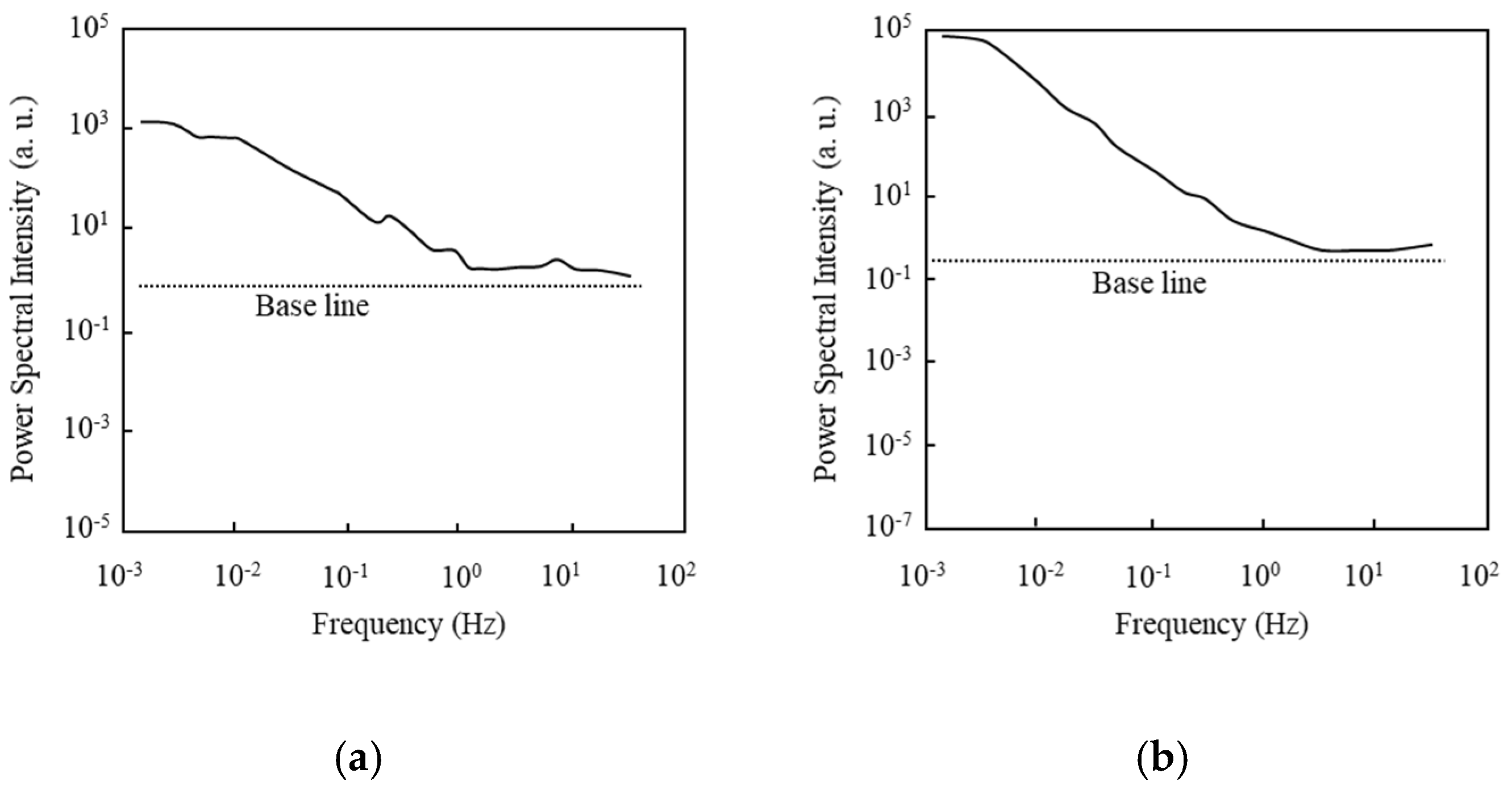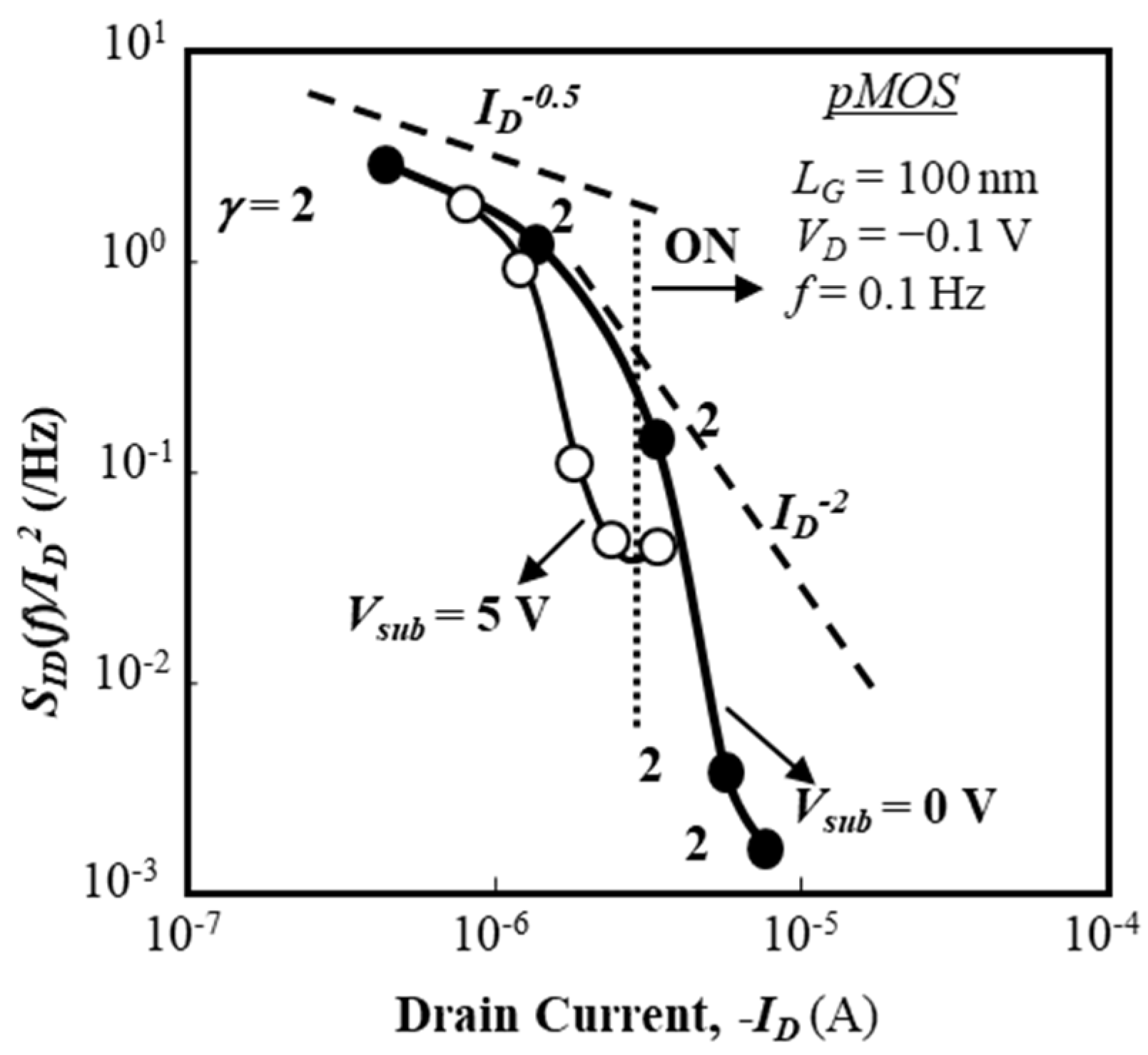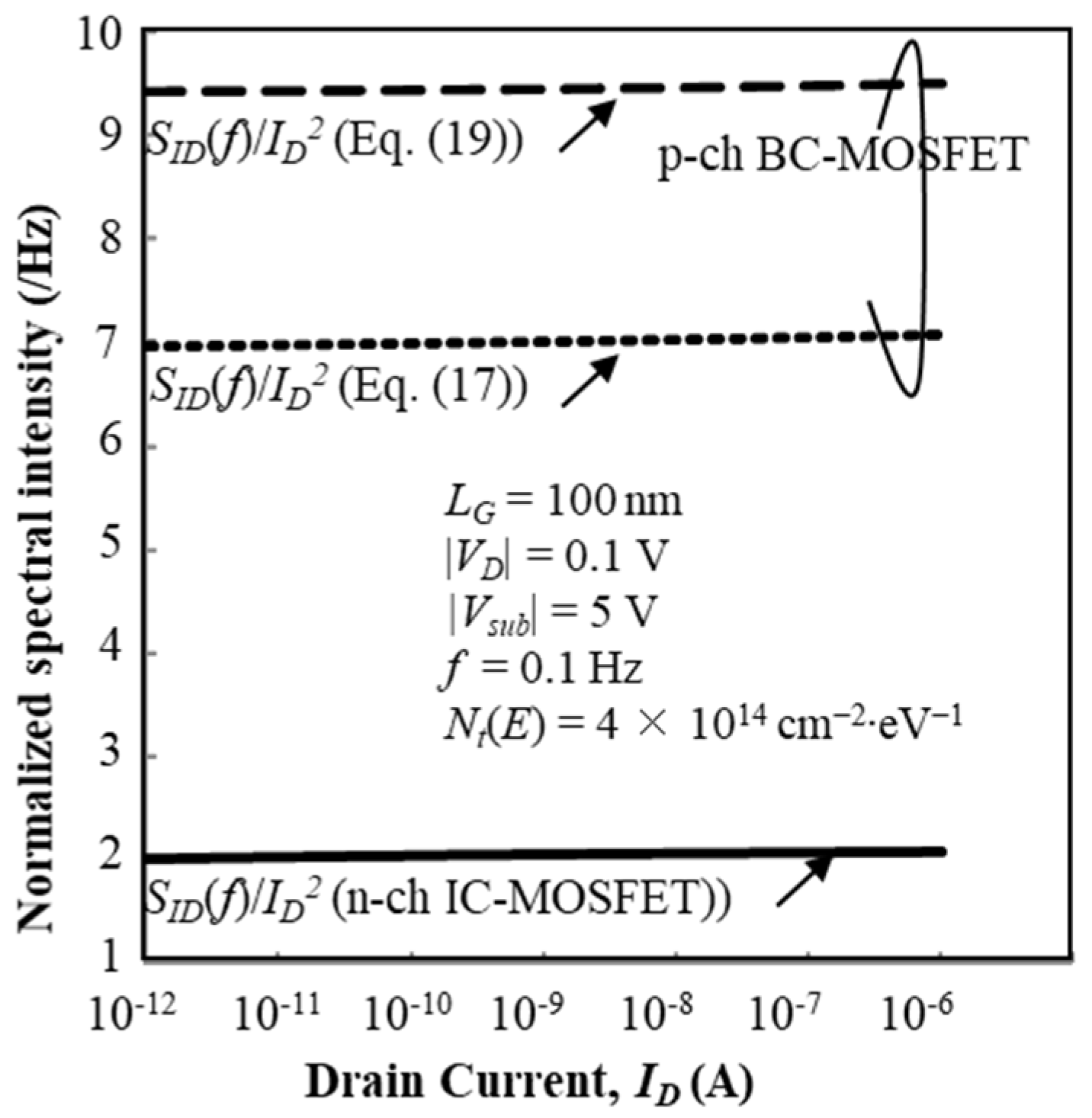Empirical and Theoretical Modeling of Low-Frequency Noise Behavior of Ultrathin Silicon-on-Insulator MOSFETs Aiming at Low-Voltage and Low-Energy Regime
Abstract
:1. Introduction
2. Experiments
3. Results and Discussion
3.1. Aspects of the Low-Frequency Noise in Long-Channel Silicon-on-Insulator Metal-Oxide-Semiconductor Field-Effect Transistor (SOI MOSFETs)
3.2. Aspects of Low-Frequency Noise in 100-nm-long Gate SOI MOSFETs
4. Theoretical Modeling for Subthreshold Current Fluctuations
4.1. Inversion-Channel MOSFET
4.2. Buried-Channel MOSFET
4.3. Theoretical Modeling of Fluctuation Sources and Brief Examination of the Model
5. Conclusions
Funding
Acknowledgments
Conflicts of Interest
References
- McWhorter, A.L. Semiconductor Surface Physics; Kingston, R.H., Ed.; University of Pennsylvania Press: Philadelphia, PA, USA, 1957; p. 207. [Google Scholar]
- Sah, C.T.; Hielsher, F.H. Evidence of the Surface Origin of the 1/f Noise. Phys. Rev. Lett. 1966, 17, 956–958. [Google Scholar] [CrossRef]
- Klaassen, F.M. Characterization of low 1/f noise in MOS transistors. IEEE Trans. Electron. Devices 1971, 18, 887–891. [Google Scholar] [CrossRef]
- Hooge, F.N. 1/f Noise. Physica 1976, 83, 14–23. [Google Scholar] [CrossRef]
- Kleinpenning, K.G.M.; Vandamme, L.K.J. Model for 1/f Noise in Metal-Oxide-Semiconductor Transistors. J. Appl. Phys. 1981, 52, 1594–1596. [Google Scholar] [CrossRef]
- Jindal, R.P.; Van der Ziel, A. Phonon fluctuation model for flicker noise in elemental semiconductors. J. Appl. Phys. 1978, 52, 2884–2888. [Google Scholar] [CrossRef]
- Handel, P.H. 1/f Noise—An “Infrared” Phenomenon. Phys. Rev. Lett. 1975, 34, 1492–1495. [Google Scholar] [CrossRef]
- Handel, P.H. Quantum Approach to 1/f Noise. Phys. Rev. A 1980, 22, 745–757. [Google Scholar] [CrossRef]
- Van der Ziel, A.; Handel, P.H.; Zhu, X.; Duh, K.H. A Theory of the Hooge Parameters of Solid-State Devices. IEEE Trans. Electron Devices 1985, 32, 667–671. [Google Scholar] [CrossRef]
- Handel, P.H. Fundamental quantum 1/f noise in semiconductor devices. IEEE Trans. Electron Devices 1994, 41, 2023–2033. [Google Scholar] [CrossRef]
- Hung, K.K.; Ko, P.K.; Hu, C.; Cheng, Y.C. A unified model for the flicker noise in metal-oxide-semiconductor field-effect transistors. IEEE Trans. Electron Devices 1990, 37, 654–665. [Google Scholar] [CrossRef]
- Stephany, J.F. A Theory of 1/f Noise. J. Appl. Phys. 1998, 83, 3139–3143. [Google Scholar] [CrossRef]
- Kiss, L.B.; Heszler, P. An Exact Proof of the Invalidity of ‘Handel’s Quantum 1/f Noise Model’, based on Quantum Electrodynamics. J. Phys. C Solid State Phys. 1986, 19, 631–633. [Google Scholar] [CrossRef]
- Nieuwenhuizen, T.M.; Frenkel, D.; van Kampen, N.G. Objection to Handel’s Quantum Theory of 1/f Noise. Phys. Rev. A 1987, 35, 2750–2753. [Google Scholar] [CrossRef]
- Van Vliet, C.M. A survey of results and future prospects on quantum 1/ƒ noise and 1/ƒ noise in general. Solid State Electron. 1991, 34, 1–21. [Google Scholar] [CrossRef]
- Vandamme, E.P.; Vandamme, L.K.J. Critical Discussion on Unified 1/f Noise Models for MOSFETs. IEEE Trans. Electron Devices 2000, 47, 2146–2152. [Google Scholar] [CrossRef]
- Omura, Y. Hooge parameter in buried-channel metal-oxide-semiconductor field-effect transistors. J. Appl. Phys. 2002, 91, 1378–1384. [Google Scholar] [CrossRef]
- Omura, Y. Possible Unified Model for the Hooge Parameter in Inversion-Layer-Channel Metal-Oxide-Semiconductor Field-Effect Transistors. J. Appl. Phys. 2013, 113, 214508–214518. [Google Scholar] [CrossRef]
- Park, H.S.; Van der Ziel, A. Dependence of MOSFET Noise Parameters in n-Channel MOSFETs on Oxide Thickness. Solid State Electron. 1982, 25, 313–315. [Google Scholar] [CrossRef]
- Magnone, P.; Crupi, F.; Giusi, G.; Simoen, E.; Claeys, C.; Pantisano, L.; Maji, D.; Rao, V.R.; Srinivasan, P. 1/f noise in drain and gate current of MOSFETs with high-k gate stacks. IEEE Trans. Device Mater. Reliab. 2009, 9, 180–189. [Google Scholar] [CrossRef]
- Nowak, E.; Kim, J.-H.; Kwon, H.Y.; Kim, Y.-G.; Sim, J.S.; Lim, S.-H.; Kim, D.S.; Lee, K.-H.; Park, Y.K.; Choi, J.-H.; et al. Intrinsic Fluctuations in Vertical NAND Flash Memories. In Proceedings of the 2012 Symposium on VLSI Technology (VLSIT), Honolulu, HI, USA, 12–14 June 2012; pp. 21–22. [Google Scholar]
- Miki, H.; Yamaoka, M.; Frank, D.J.; Cheng, K.; Park, D.-G.; Leobandung, E.; Torii, K. Voltage and Temperature Dependence of Random Telegraph Noise in Highly Scaled HKMG ETSOI nFETs and its Impact on Logic Delay Uncertainty. In Proceedings of the 2012 Symposium on VLSI Technology (VLSIT), Honolulu, HI, USA, 12–14 June 2012; pp. 137–138. [Google Scholar]
- Chen, J.; Hirano, I.; Tatsumura, K.; Mitani, Y. Comprehensive Investigations on Neutral and Attractive Traps in Random Telegraph Signal Noise Phenomena using (100)- and (110)-Orientated CMOSFETs. In Proceedings of the 2012 Symposium on VLSI Technology (VLSIT), Honolulu, HI, USA, 12–14 June 2012; pp. 141–142. [Google Scholar]
- Wei, C.; Jiang, Y.; Xiong, Y.-Z.; Zhou, X.; Singh, N.; Rustagi, S.C.; Lo, G.Q.; Kwong, D.-L. Impact of Gate Electrodes on 1/f Noise of Gate-All-Around Silicon Nanowire Transistors. IEEE Electron Devices Lett. 2009, 30, 1081–1083. [Google Scholar]
- Ioannidis, E.G.; Theodorou, C.G.; Karatsori, T.A.; Haendler, S.; Dimitriadis, C.A.; Ghibaudo, G. Drain-Current Flicker Noise Modeling in nMOSFETs From a 14-nm FDSOI Technology. IEEE Trans. Electron Devices 2015, 62, 1574–1579. [Google Scholar] [CrossRef]
- Ghibaudo, G.; Roux, O.; Nguyen-Duc, C.; Balestra, F.; Brini, J. Improved Analysis of Low Frequency Noise in Field-Effect MOS Transistors. Phys. Stat. Sol. 1991, 124, 571–581. [Google Scholar] [CrossRef]
- Ghibaudo, G. Impact of Device Scaling on LF Noise in CMOS Technologies. In Proceedings of the 17th International Conference Mixed Design of Integrated Circuits and Systems, Prague, Czech Republic, 1–4 June 2003; pp. 301–308. [Google Scholar]
- Rhayem, J.; Rigaud, D.; Eya’a, A.; Valenza, M. 1/f Noise in Metal-Oxide-Semiconductor Transistors Biased in Weak Inversion. J. Appl. Phys. 2001, 89, 4192–4194. [Google Scholar] [CrossRef]
- Ito, T.; Sato, S.; Omura, Y. Characterization of Noise Behavior of Ultrathin Inversion-Channel and Buried-Channel SOI MOSFETs in the Subthreshold Bias Range. In Proceedings of the 2014 IEEE International Meeting for Future of Electron Devices, Kansai (IMFEDK), Kyoto, Japan, 19–20 June 2014; pp. 46–47. [Google Scholar]
- Jin, W.; Chan, P.C.H.; Fung, S.K.H.; Ko, P.K. Shot-noise-induced excess low-frequency noise in floating-body partially depleted SOI MOSFET’s. IEEE Trans. Electron Devices 1999, 46, 1180–1185. [Google Scholar] [CrossRef]
- Workman, G.O.; Fossum, J.G. Physical noise modeling of SOI MOSFETs with analysis of the Lorentzian component in the low-frequency noise spectrum. IEEE Trans. Electron Devices 2000, 47, 1192–1201. [Google Scholar] [CrossRef]
- Gross, B.J.; Sodini, C.G. 1/f noise in MOSFETs with ultrathin gate dielectrics. In Proceedings of the 1992 International Technical Digest on Electron Devices Meeting, San Francisco, CA, USA, 13–16 December 1992; pp. 881–884. [Google Scholar]
- Morshed, T.; Devireddy, S.P.; Rahman, M.S.; Celik-Buller, Z.; Tseng, H.-H.; Zlotnicka, A.; Shanware, A.; Green, K.; Chambers, J.J.; Visokay, M.R.; et al. A new model for 1/f noise in high-k MOSFETs. In Proceedings of the 2007 IEEE International Electron Devices Meeting, Washington, DC, USA, 10–12 December 2007; pp. 561–564. [Google Scholar]
- Simoen, E.; Mercha, A.; Claeys, C.; Lukyanchikova, N.; Garbar, N. Critical discussion of the front-back gate coupling effect on the low-frequency noise in fully depleted SOI MOSFETs. IEEE Trans. Electron Devices 2004, 51, 1008–1016. [Google Scholar] [CrossRef]
- Chandrakasan, A.P.; Daly, D.C.; Finchelstein, D.F.; Kwong, J.; Ramadas, Y.K.; Sinangil, M.E.; Sze, V.; Verma, N. Technologies for Ultradynamic Voltage Scaling. Proc. IEEE 2010, 98, 191–214. [Google Scholar] [CrossRef]
- Vitale, S.A.; Wyatt, P.W.; Checka, N.; Kedzierski, J.; Keast, C.L. FESOI Process Technology for Subthreshold-Operation Ultralow-Power Electronics. Proc. IEEE 2010, 98, 333–342. [Google Scholar] [CrossRef]
- Simoen, E.; Andrade, M.G.C.; Almeida, L.M.; Aoulaiche, M.; Caillat, C.; Jurczak, M.; Claeys, C. On the Variability of the Low-Frequency Noise in UTBOX SOI nMOS-FETs. J. Integr. Circ. Syst. 2013, 8, 71–77. [Google Scholar]
- Van Haartman, M.; Oestling, M. Effect of channel positioning on the 1/f noise in silicon-on-insulator metal-oxide semiconductor field-effect transistors. J. Appl. Phys. 2007, 101, 034506–034509. [Google Scholar] [CrossRef]
- Gaubert, P.; Teramoto, A.; Sugawa, S. 1/f Noise Performances and Noise Sources of Accumulation Mode Si(100) n-MOSFETs. In Proceedings of the International Conference on Solid State Devices and Materials, Sapporo, Japan, 27–30 September 2015; pp. 96–97. [Google Scholar]
- Lee, J.-H.; Kim, S.-Y.; Cho, I.; Hwang, S.; Lee, J.-H. 1/f Noise Characteristics of Sub-100 nm MOS Transistors. J. Semicond. Technol. Sci. 2006, 6, 38–42. [Google Scholar]
- Omura, Y.; Nakashima, S.; Izumi, K.; Ishii, T. 0.1-μm-Gate, Ultrathin-Film CMOS Devices Using SIMOX Substrate with 80-nm-Thick Buried Oxide Layer. IEEE Trans. Electron Devices 1991, 40, 675–678. [Google Scholar]
- Kochelap, V.A.; Sokolov, V.N.; Bulashenko, O.M.; Rubi, J.M. Coulomb Suppression of Surface Noise. Appl. Phys. Lett. 2001, 78, 2003–2005. [Google Scholar] [CrossRef]
- Kochelap, V.A.; Sokolov, V.N.; Bulashenko, O.N.; Rubi, J.M. Theory of Surface Noise under Coulomb Correlations between Carriers and Surface States. J. Appl. Phys. 2002, 92, 5347–5358. [Google Scholar] [CrossRef]
- Omura, Y. A simple model for substrate current characteristics in short-channel ultrathin-film metal-oxide-semiconductor field-effect transistors by separation by implanted oxygen. Jpn. J. Appl. Phys. 1995, 34, 4722–4727. [Google Scholar] [CrossRef]
- Omura, Y. Two-Dimensionally Confined Injection Phenomenon at Low Temperatures in Sub-10-nm-Thick SOI Insulated-Gate p-n-Junction Devices. IEEE Trans. Electron Devices 1996, 43, 436–443. [Google Scholar] [CrossRef]
- Ishiyama, T.; Omura, Y. Analysis of Interface Microstructure Evolution in Separation by IMplanted OXygen (SIMOX) Wafers. Jpn. J. Appl. Phys. 2000, 39, 4653–4656. [Google Scholar] [CrossRef]
- Arnold, E. Conduction Mechanisms in Bandtails at the SiO2 Interface. Surf. Sci. 1976, 58, 60–70. [Google Scholar] [CrossRef]
- Omura, Y.; Nagase, M. Low-Temperature Drain Current Characteristics in Sub-10-nm-Thick SOI nMOSFET’s on SIMOX (Separation by IMplanted OXygen) substrates. Jpn. J. Appl. Phys. 1995, 34, 812–816. [Google Scholar] [CrossRef]
- Omura, Y.; Sato, S. Theoretical Models for Low-Frequency Noise Behaviors of Buried-Channel MOSFETs. In Proceedings of the 2017 IEEE SOI-3D-Subthreshold Microelectronics Technology Unified Conference (S3S), Burlingame, CA, USA, 16–19 Octorber 2017. [Google Scholar]
- Sze, S.M.; Ng, K.K. Physics of Semiconductor Devices, 3rd ed.; Wiley: Hoboken, NJ, USA, 2007; p. 314. [Google Scholar]
- Kogan, S. Electronic Noise and Fluctuations in Solids; Cambridge University Press: Cambridge, UK, 1996; Chapter 3. [Google Scholar]
- Omura, Y.; Ohwada, K. Threshold and Subthreshold Characteristics Theory for a Very Small Buried-Channel MOSFET Using a Majority-Carrier Distribution Model. Solid State Electron. 1981, 24, 301–308. [Google Scholar] [CrossRef]












| Devices | ts | tox | tBOX | NA |
|---|---|---|---|---|
| IC-MOSFET | 30 nm | 7 nm | 80 nm | 5 × 1017 cm−3 |
| BC-MOSFET | 30 nm | 7 nm | 80 nm | 4 × 1017 cm−3 |
© 2018 by the author. Licensee MDPI, Basel, Switzerland. This article is an open access article distributed under the terms and conditions of the Creative Commons Attribution (CC BY) license (http://creativecommons.org/licenses/by/4.0/).
Share and Cite
Omura, Y. Empirical and Theoretical Modeling of Low-Frequency Noise Behavior of Ultrathin Silicon-on-Insulator MOSFETs Aiming at Low-Voltage and Low-Energy Regime. Micromachines 2019, 10, 5. https://doi.org/10.3390/mi10010005
Omura Y. Empirical and Theoretical Modeling of Low-Frequency Noise Behavior of Ultrathin Silicon-on-Insulator MOSFETs Aiming at Low-Voltage and Low-Energy Regime. Micromachines. 2019; 10(1):5. https://doi.org/10.3390/mi10010005
Chicago/Turabian StyleOmura, Yasuhisa. 2019. "Empirical and Theoretical Modeling of Low-Frequency Noise Behavior of Ultrathin Silicon-on-Insulator MOSFETs Aiming at Low-Voltage and Low-Energy Regime" Micromachines 10, no. 1: 5. https://doi.org/10.3390/mi10010005




